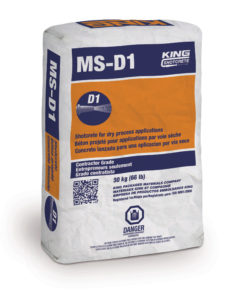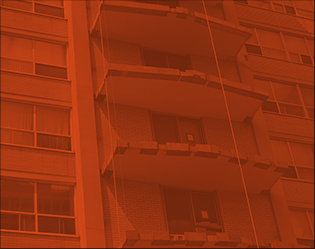Performance of Dry-Mix Shotcrete in Permafrost Environment
MS-D1
• Air-entrainment provides superior resistance to freeze-thaw cycling and salt-scaling resistance.
• Improved adhesive and cohesive plastic properties.
• Significantly reduced rebound, resulting in lower material usage.
It is well established that if the temperature of cement and water is below –10°C (14°F), there will not be any hydration reaction [1]. However, if the temperature of the materials is slightly higher combined with the use of a brine solution in order to prevent the water from freezing, the hydration reaction may occur. The main goal of this test program was to develop a shotcrete mixture that would set and harden in very cold conditions when applied on permafrost.
In order to achieve the objective, it was important to develop a mix that would rapidly generate a high heat of hydration. The cold ambient air would cool down the shotcrete but the heat released during the hydration process would allow the hydration of cement to proceed until the temperature of fresh shotcrete decreased to the freezing temperature of the brine solution (brine is a solution of calcium chloride). At that temperature, brine freezes and the process of hydration remains suspended until such time as thawing takes place.
A laboratory test program (not presented in this paper) was used to develop two dry-mix
shotcrete mixes for performance evaluation at a mine near the arctic circle under permafrost
conditions. The mixes evaluated had very short initial and final set times, generated the most
heat of hydration during the first minutes and developed the highest compressive strength
during the first few hours [2]. It was therefore expected that these mixes could be applied on
frozen surfaces and would be able to set and develop adequate mechanical properties.
Field Investigation-Ground Support Shotcrete Test Program
The field investigation was conducted at the Katinniq Mine (Province of Québec, Canada)
operated by Société Minière Raglan du Québec, Falconbridge Limited [3]. The mine is located a few hundred kilometres south of the Arctic Circle. The shotcrete program was conducted to evaluate the performance of two shotcrete mixes applied under cold temperatures on permafrost rock. The objectives and the details of the program are described in the following sections.
Objectives
The main objective of the shotcrete program was to determine the ability of these specially
designed shotcrete mixes to provide competent underground rock support in a permanent
excavation in the mine. Ambient rock and air temperatures ranged between -10°C and +3°C
(14°F and 37°F), depending on the area in the mine. Areas near the ventilation raises can reach temperatures as low as –25°C (-13°F). The two shotcrete mixes developed in the laboratory investigation were used to conduct the trial under actual underground conditions in permafrost.
-Shotcrete – Mix A was designed to meet the ground support requirements for the Katinniq
Mine at early ages. When shotcrete is applied onto frozen rock surfaces, the hydration
process of the cement must develop enough heat of hydration to prevent the water in the
mix from freezing. However, the possibility that this heat might thaw the permafrost rock
beneath the shotcrete also has to be monitored.
-Shotcrete – Mix B was developed for underground construction, (fences, barricades,
sumps, ventilation walls, etc.). Although also tested for ground support applications,
Mix B was principally formulated to be able to perform when exposed to cold curing
temperatures, i.e. when not in contact with any frozen rock surfaces.
Site Preparation
Laboratory testing of the shotcrete mixes considered both the air and rock temperatures, as well as the temperature of the dry materials. At the mine site, pre-bagged materials were stored outside in a designated area and therefore exposed to extreme low temperatures. The dry materials reached temperatures on surface as low as –15°C (5°F) prior to the application.
As shown in the pictures in Figure 2, warehouse facilities were not available at the time and most of the mine’s goods and supplies were stored outside. Several systems such as the post system were therefore developed in an effort to locate required containers during the winter season. The tip of each post was marked or coloured in order to indicate a specific container. Pictures in Figure 3 illustrate the method described.
In order to assess the best performance of the shotcrete, special bulk bags with plastic liners were developed to prevent problems related to premature hydration of the cementitious materials from moisture ingress.
Hardware Installation
In order to meet the objectives predetermined in the planning of the project, it was important to measure the air, rock and shotcrete temperatures. Temperature probes were therefore installed in both the wall and the shotcrete. A Ground Movement Monitor (GMM) was also incorporated into the temperature probes to measure any possible delamination of the shotcrete from the rock. Some probes were installed as deep as 1700 mm (67 in.) into the rock to determine a temperature profile. A picture and a schematic of the temperature probes (and a GMM) and its location relative to the applied shotcrete is presented in Figures 4 and 5.
Rock wall panel test sites (600 x 600 mm (24 in. x 24 in.)) were also prepared to allow measurement of temperature evolution measurements using various thicknesses of shotcrete.
This was done in order to determine what thickness of shotcrete would be required for the full
scale tests described above. The results would also help to determine the effect of thickness of
the shotcrete on the heat evolution generated during the first stages of the hydration process.
Thermisters were also used and located in the middle of the shotcrete layer and were connected to a multi-meter to allow manual monitoring for the first 45 minutes of the shotcrete hydration process. Three different shotcrete thickness’ were evaluated: 25, 50 and 75 mm (1, 2 and 3 inches).
Dry-Mix Shotcrete Application
Both mixes were designed with the same aggregate gradation, which combined fine (concrete
sand) and coarse (10 mm stone) particles. This gradation provided proper compaction of the
material and kept a constant flow of the material travelling through the shotcrete hoses.
The water used underground at the mine for shotcrete applications was a calcium chloride water solution which prevented the water from freezing. At the time of testing, this brine solution was constantly recycled between two sumps underground. The recycled brine solution used for shotcreting was taken from the upper sump which was delivering a solution of better quality brine.
Field In-Situ Testing of Shotcrete
Rock wall test panels were initially shot with various thicknesses to monitor the temperature
evolution generated during the first stages of the hydration process. This information was used to assess proper thickness of shotcrete for the full scale test. The temperatures were monitored manually and the results are presented in Figure 7.
For Mix A, results obtained from thermisters at 50 mm and 75 mm thicknesses indicated the
same temperature increase of approximately 8°C. The thickness of shotcrete did therefore not
affect the temperature development. Both panels experienced a drop in temperature (over
1°C) immediately after shooting. This drop in temperature was caused by the airflow in the
shotcrete. In both cases, the temperature of the cold dry materials was measured at – 10°C at
the time of application.
For Mix B, only one panel was shot, with a thickness of 50 mm. As illustrated in Figure 7, the
temperature increase was not as evident as in Mix A. After similar temperature drop immediately following shooting, the temperature increased by about 7°C to just over 3°C. It took nearly twice as long to reach the highest temperature, (over 30 minutes). As expected, Mix A provided faster and higher heat gain than Mix B.
Full Scale Test – Temperature Probe
Temperature curves were obtained from the datalogger for different positions along the probes. Although the complete analysis of the temperature evolution curves is beyond the scope of this paper, it is interesting to note that the thermisters located in the shotcrete and at the interface rock – shotcrete showed a very rapid temperature increase (about 7°C within minutes; note that the temperature of the dry materials was approximately –10°C at the time of application). This increase allowed the hydration of cement to take place for a sufficient period. Also, it is of interest to note the extent to which the rock is warmed by the actual shotcrete: the gauges at the interface rock – shotcrete and 200 mm into the rock indicated different temperature increases. These differences are directly related to their depth into the rock. For instance, thermisters installed at depths of 1.7 m remained constant at temperatures between 0 and 1°C for the entire trial period. The shallowest thermister, at a depth of 200 mm, seemed to be influenced by the heat of hydration of the shotcrete. In fact, the temperature increased by about 1°C during the six hour period following shotcrete application.
According to these test results, it appears that this particular shotcrete mix generates enough heat to allow the hydration of the cement to proceed and develop mechanical strength under such severe cold conditions. Set time and compressive strength development tests at early ages were therefore conducted and high performance was achieved. The results also verified that this exothermic reaction will not significantly increase the temperature of the rock to cause instability. Any effect of the rock temperature will only be encountered to the relatively shallow depth of 200 mm into the permafrost.
Conclusions
Overall, the main objective of the shotcrete test program was achieved and valuable information
was collected throughout the entire trial. In particular, Shotcrete Mix A was successfully developed to perform in permafrost and therefore provided competent underground rock support
under such conditions. The installation of temperature probes allowed determination of a rock
temperature profile. This monitoring system indicated that Mix A developed enough heat to allow the hydration of the cement to proceed and thus provide the development of rapid set and early age strengths, which are the most important requirements for proper ground support. The data also verified that the heat generated during the hydration process does not significantly increase the temperature at a depth of 200 mm or more into the permafrost rock. Since this shotcrete test program, shotcrete was implemented into the mining cycle. Significant production increase was reported and several types of shotcrete equipment were therefore evaluated in order to increase efficiency of the shotcrete operations underground. At this time, long term results from shotcreted areas are encouraging.







